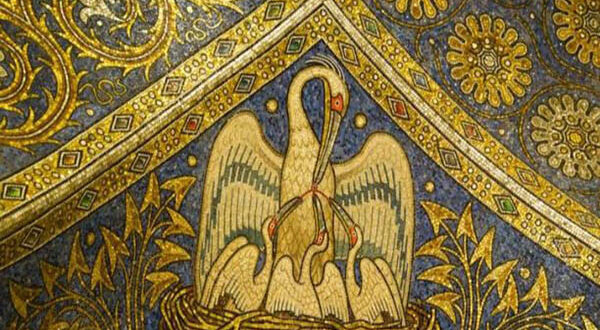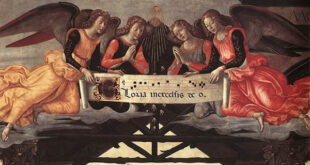INTRODUCTION: A BIRD, AN ALTAR, AND AN ETERNAL MESSAGE
In many Catholic churches around the world, if you look closely at the tabernacle—the small golden “box” where the Blessed Sacrament is reserved—you might spot a peculiar image: a pelican piercing its own breast with its beak, feeding its young with its own blood. What is this bird doing there? Why would such an image be placed in the holiest part of the church? What mystery lies behind this ancient symbol that has survived through centuries of sacred art, liturgy, and spirituality?
This article seeks to take you into the heart of that mystery. Not just to tell you the story of the pelican in Catholic tradition, but to help you discover how this symbol can transform your way of living the Eucharist, of looking at the tabernacle, and, above all, of loving as Christ loved us: to the point of shedding blood.
1. THE ANCIENT MYTH THAT FORESHADOWS THE GOSPEL
The symbolism of the pelican comes from an ancient belief, widely held during the Middle Ages, according to which this bird, in times of famine, would pierce its chest with its beak to feed its chicks with its own blood, thereby saving them from death.
Though this behavior is more legend than biological fact, the story contains an allegorical beauty that Christians quickly recognized. For the Fathers of the Church, the pelican became a natural foreshadowing of Christ, the true Redeemer, who “feeds us with His Flesh and gives us His Blood to drink” (cf. John 6:53–56).
The image soon entered liturgical iconography, religious poetry, and sacred art—not out of mere ornamentation, but because it visually expressed a profoundly Christian truth: the self-giving life of Christ, offered without measure out of love.
2. THEOLOGY OF THE PELICAN: A EUCHARISTIC CHRIST
The pelican in the tabernacle is not just art—it is theology. It is not decoration—it is visible doctrine. Its presence reminds us that at the center of the Catholic faith is a Person who gave Himself entirely for us and continues to do so each day in the Eucharist.
St. Thomas Aquinas, in his famous hymn “Adoro te devote,” dedicates a line full of tenderness to this image:
“Pie pellicane, Iesu Domine, me immundum munda tuo sanguine.”
(“O Good Pelican, Lord Jesus, cleanse me, the unclean, with Your Blood.”)
Here, Thomas not only reiterates the doctrine of transubstantiation (Christ truly present in the consecrated Host), but he acknowledges that this nourishment is the fruit of a wound: Christ has been pierced for us (cf. Isaiah 53:5; John 19:34).
The pelican thus represents a threefold truth:
- The love of Christ poured out.
- The sacrifice that saves.
- The Eucharist as the source of life.
3. PASTORAL SIGNIFICANCE: FROM SYMBOL TO LIFE
The pelican challenges us. It is not enough to see and admire it; we must let its message pierce our hearts.
What is this symbol saying to your soul today?
- That Christian faith is not comfort, but self-giving.
- That true love involves sacrifice, loss, and radical generosity.
- That Christ is truly present in the tabernacle, silent and wounded, like the bleeding pelican who continues to give His life for you.
In a world that confuses love with pleasure, service with self-interest, and sacrifice with failure, the pelican in the tabernacle offers a countercultural lesson: to love is to lay down one’s life, just as Christ does each time you receive Him in Holy Communion.
4. A PRACTICAL GUIDE FOR LIVING AS CHILDREN OF THE PELICAN
Now let me offer you a theological and pastoral guide to help you apply this symbol in your daily life. The goal is not merely to admire the pelican but to imitate it, because Christ calls us to become bread broken and blood poured out for the world.
A. BEFORE THE TABERNACLE: ADORE WITH AWARENESS
- Never pass in front of the tabernacle without a deliberate genuflection. The true Pelican is there.
- Make visits to the Blessed Sacrament. A simple prayer, a loving gaze, a silence full of faith—everything counts before Him.
- Contemplate the pelican (if one is depicted). If not, imagine it, and say with faith: “Thank You, Lord, for giving me Your life.”
B. DURING MASS: PARTICIPATE AS A VICTIM
- At every Mass, Christ once again gives Himself like the pelican. Don’t be a spectator. Join in His sacrifice.
- Offer your sufferings, your work, your prayers. Unite your blood to His.
- When you receive Communion, do so with fervor, humility, and gratitude. You are receiving the very One who was pierced for you.
C. IN DAILY LIFE: LOVE UNTIL IT HURTS
- Love your family like the pelican: even when it costs, even when it hurts.
- Truly forgive. Be generous. Be a servant. Make your life a Eucharist.
- If you are a priest, remember that you are configured to this Pelican: you too are called to lay down your life for your flock.
5. APPLICATION IN TODAY’S WORLD
In a society marked by individualism, narcissism, and superficiality, the pelican in the tabernacle is a silent cry that denounces the lack of self-giving, the rise of selfishness, and spiritual apathy.
Now more than ever, we need Catholics who live “Eucharistically”: ready to break themselves open, to bleed for love, to hold nothing back.
The pelican does not protect itself. It gives itself. Like Christ. Like Mary. Like the saints. Like you are called to do.
6. BIBLE AND PELICAN: A WOUND OF LOVE
Jesus says in the Gospel:
“Whoever eats My flesh and drinks My blood has eternal life, and I will raise him on the last day.” (John 6:54)
The pelican symbolizes precisely this: a living Christ, who allows Himself to be torn open so you might live.
And the prophet Isaiah had already foretold that sacrifice:
“He was despised and rejected by men, a man of sorrows, and familiar with suffering… pierced for our transgressions, crushed for our iniquities.” (Isaiah 53:3, 5)
The pelican bleeds, but its blood brings life. That is the paradox of Christian love.
CONCLUSION: A CALL TO EUCHARISTIC LIFE
The next time you enter a church and see a pelican on the tabernacle, stop and reflect. It is not an ornament. It is a living icon of the greatest love.
Remember that Christ is there, like that mystical pelican, giving you His blood, feeding you from His wound, waiting for you in silence.
And you—will you be like Him? Will you dare to live Eucharistically? Will you let your heart be opened so that others may live?
The pelican in the tabernacle is not a symbol of the past. It is an urgent call for the present. And a promise of eternal life.
“The pelican wounds itself to give life to its young. Christ allowed Himself to be wounded to give life to you. Never forget that.”






